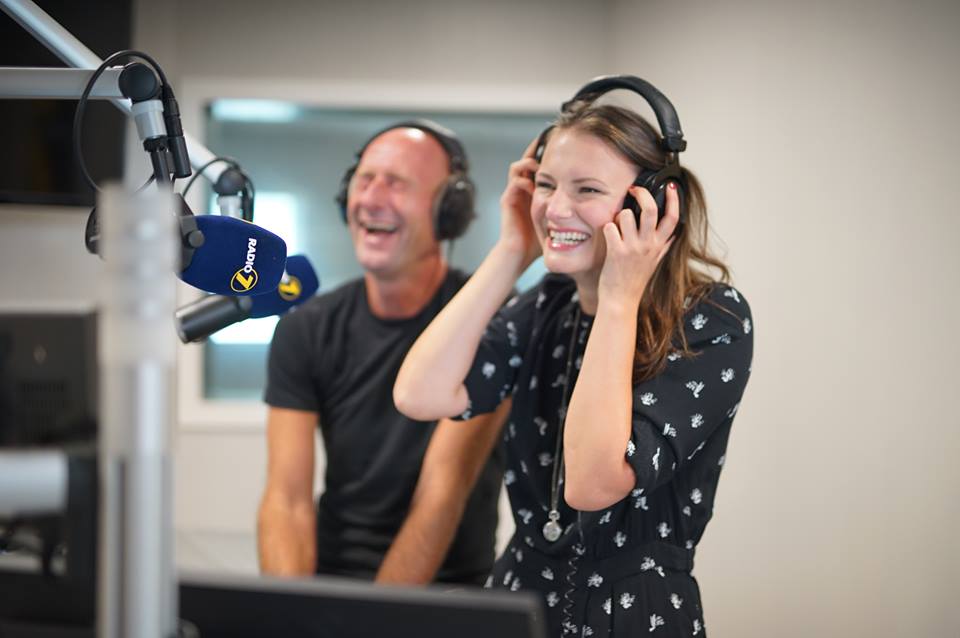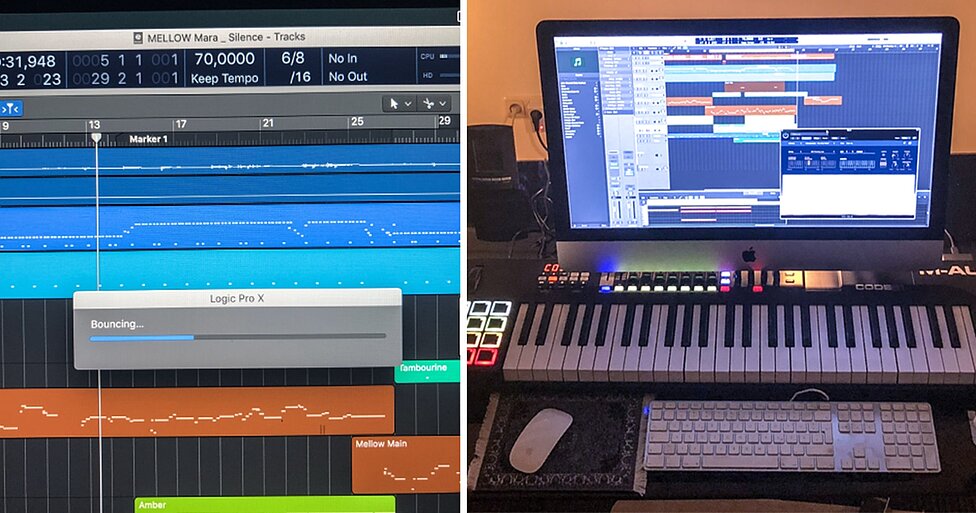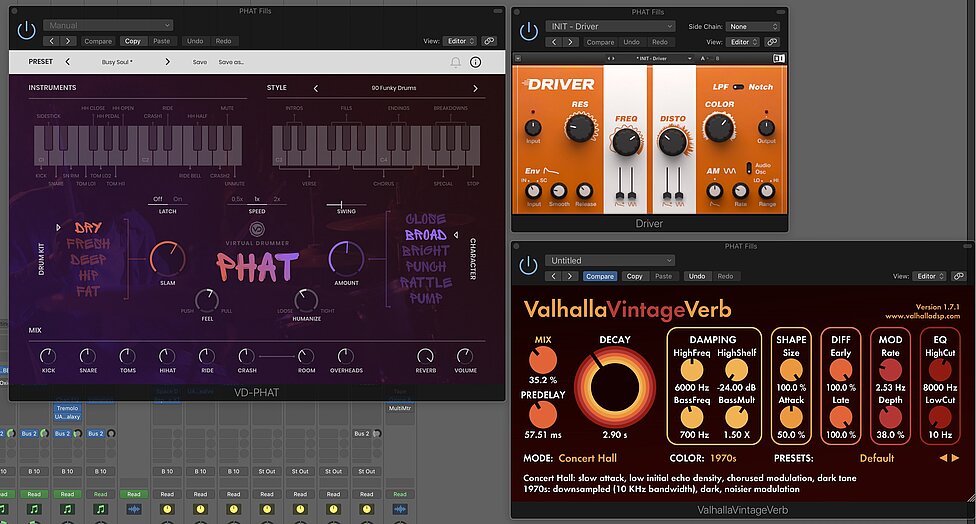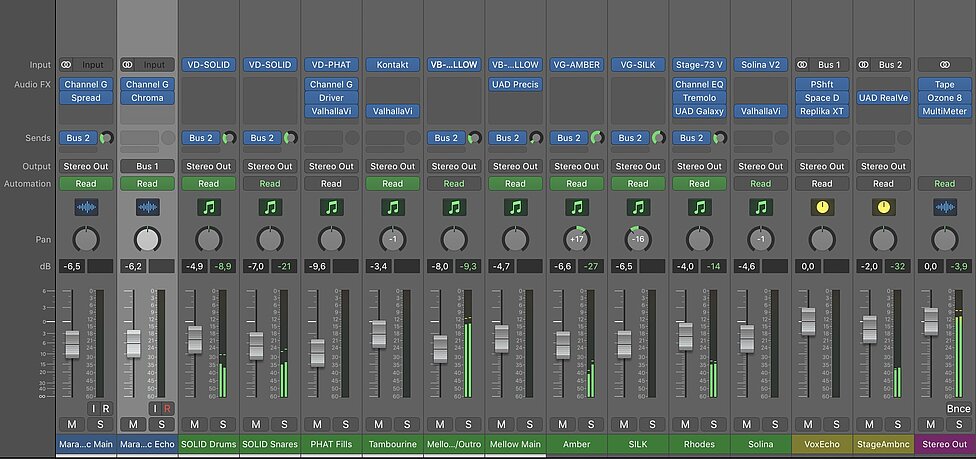Create a Beautiful Pop Ballad with MELLOW
Watch the making of "Silence", a beautiful, haunting ballad and the first of a series of songs created with Virtual Musicians by ujam
NOVEMBER 16TH, 2018
“Silence”, written by Mara Kim and produced by UJAMs Peter Gorges, is the first of a series of songs created with Virtual Musicians by UJAM.
“Silence” is a beautiful, haunting ballad, not at least thanks to the new Virtual Bassist Mellow. In this exclusive Production Insight feature, Peter shares how he created “Silence”. Thanks to a basic-but-terrific song idea by singer and songwriter Mara Kim:
Mara Kim in the studio

The Song Idea
Let’s hear it from Peter himself: We make the claim that our virtual instruments are designed to create professional results fast. So, I wanted to create a showcase of exactly that to share with users.
I asked a few songwriter friends for song material that we could use. Mara Kims sketch of “Silence” stuck out immediately! It was just an MP3 of her singing to a basic piano chord progression. It was all there in that first demo, as you can hear here:
As a start, I sent Mara a basic piano track which she recorded the final vocals to, and that is what you hear in the song. From there it was just building the arrangement around it without “breaking the spell”, if you will. I set up a project with Maras vocals and went from there. From beginning to end, it all lived in my iMac and Logic Pro X.
Using Virtual Bassist in Logic Pro X

First Steps
I started by building a “band” foundation. The challenge here was to leave room for the fragility and the emotional build-up of vocals and lyrics. It’s tempting to create demos where you make the instruments stick out.
To me, those instruments shine “in their natural habitat”. It’s more about supporting the song and sitting in the mix, rather than showing them off.
Drums
Among our three Virtual Drummers, I went for SOLID. Simply because it’s the “elegant, seasoned” one and is great at ballads.
This one and all following examples are “Focus Mixes”, where you hear one track in focus, but in the context of the others.
I used the most subtle sound settings within SOLID – Soft Kit, no Slam, Smooth mix preset and even just a bit of that. You can follow the drum notes on the stylized keyboard shown in the video as you listen along a piece of the intro into the chorus.
Originally, I used built-in patterns for the layout. I replaced them later by playing note for note so I had individual control – because the gaps were more important than the notes. Also, to retain a live feel, I did not quantize my “drum performance”.
To create the dynamic build-up, I used very low velocities in the intro and played harder over time.
Bass
The most defining instrument except for the vocals is the bass. That was defined by the availability of Virtual Bassist MELLOW. My first version of Silence used an electric bass and was a little more “electro-romantic” overall.
However, when I got a first version of Virtual Bassist Mellow into my hands, I completely revised the arrangement. I saw the acoustic bass as a second “voice”, like an answer to Mara Kims vocals. An acoustic bass has this quality that plays nice with vocals – I know of no other bass instrument that does that.
I took a lot of time re-recording and improvising the lines with Virtual Bassist Mellow, and ended up using two instances/tracks. One for the Intro/Outro, where the bass almost communicates with the vocals. One for the main part, where it works with the drums to create the foundation. Like the drums, I didn’t quantize anything.
Mellow is played with low-velocities in this intro part. Watch the stylized keyboard at the top to follow the performance. You can see frequent note-binding for real legato. The overall setting is relatively neutral with the “natural” character and the “round” mic preset. It’s focussing on “melodic” rather than “foundation”.
Guitars
Between the rhythm section and the harmonic keyboard tracks – the electric piano and the strings that come on later in the song – I wanted some kind of rhythmic and harmonic glue. Not as rhythmical as the rhythm section, yet not as harmony-laden as the keyboards.
Also, I didn’t want to subtract in any way from the amazing organic, natural, breathy character that Virtual Bassist MELLOW and the vocals brought with them.
So it was kind of logical to reach for acoustic guitars. I wanted a strummed one to drive a little bit in the slow parts, and an arpeggio for rhythmic glue. I chose Virtual Guitarist AMBER for the first and Virtual Guitarist SILK for the second one.
The phrases and settings I use are pretty standard as you can see, and I let the guitarists do all the work for me.
As always, you may want to follow the performance on the stylized keyboard. That way, you can see how varying between up- and downstrokes and phrases makes a difference. This example is a bit enhanced in that regard compared to the final mix.
VG AMBER is set to “Pickup” here for better contrast when playing in tandem with VG SILK later. Also, the sound is kept pretty unprocessed.
Following the keyboard, note how Virtual Guitarist SILK is a bit different in that you can play separate bass notes. In this example, there’s a softer first and a more vivid second part with some in-bar phrase variation. Timing, feel and variance are set pretty loosely to create the impression of a rather relaxed playing feel. In the mix, Virtual Guitarist SILK is set against Virtual Guitarist AMBER so we’re using only one microphone and no doubling.
Effects and Sound-Shaping
Two times in the song, you hear a distant drum fill. I created it by “abusing” a Virtual Drummer PHAT funky fill. First, adding a resonant lowpass filter and overdrive (NI Driver) and then running it into the Valhalla VintageVerb. Here’s the setup:
Virtual Drummer PHAT funky fill

Mixing
There is very little in the way of elaborate mixing in this track. Simply because UJAM Instruments come with half the engineer already built-in, and I wanted to show how far that carries if you’re not an engineer.
Also, admittedly, my active mixing skills absolutely don’t live up to my passive know-how. Therefore, the mix is pretty straightforward:
- Most of the work went into the vocals. Manual breath and pop automation, de-essing, EQ and layers of room to make the vocals big and always present without making them “loud”.
- The drums created by SOLID only use SOLIDs own internal mixing console – a preset and an amount control – done.
- There’s only subtle internal compression and EQ used in the basses. Adding a little extra control of the low end in the main part using a UAD Precision Channel.
- Guitars are completely unprocessed. The instruments come with a subtly pre-mixed sound out of the box. That was exactly what I wanted in this track.
- To create a “live stage” impression, all tracks send more or less signal to a room ambience bus.
Here’s the entire mixer setup if you’re interested …
The mixer setup

Mastering
I was looking for a vintage, compact, super-subtly lo-fi 60s/70s sound here. As I said, I’m not a sound engineer, so I went for the dead obvious. I ran the master channel through a Softube “Tape” plugin, which does an amazing job of emulating a 2-inch tape machine, including a beautiful noise floor.
The actual mastering job is performed by Izotopes Ozone 8, where I used a standard preset without any adjustments.
So, I hope this article and the included media have given you a bit of helpful insight. Even more importantly, inspired you to use some of it in your own music.
Stay up to date
Sign up and we’ll send you an e-mail with product news and helpful stuff every now and then. You may unsubscribe at any time.
Defy Limits
We develop software solutions that enable people to create, consume and interact with music.

